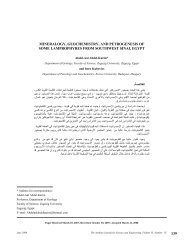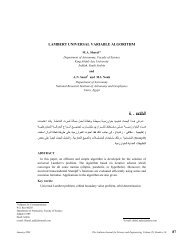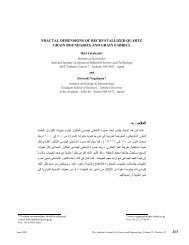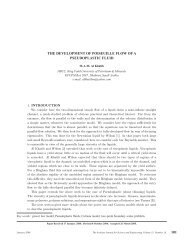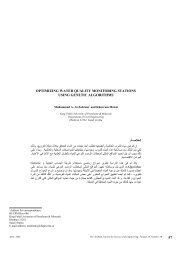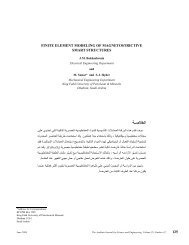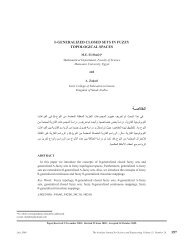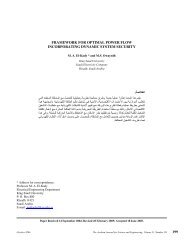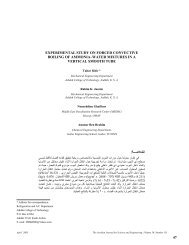pp.53-60 - Arabian Journal for Science and Engineering
pp.53-60 - Arabian Journal for Science and Engineering
pp.53-60 - Arabian Journal for Science and Engineering
Create successful ePaper yourself
Turn your PDF publications into a flip-book with our unique Google optimized e-Paper software.
SYNTHESIS, CHARACTERIZATION AND NONLINEAR<br />
OPTICAL PROPERTIES OF FOUR NOVEL SCHIFF BASE<br />
COMPOUNDS<br />
Iran Sheikhshoaie * <strong>and</strong> Samira Saeednia<br />
Department of Chemistry<br />
Shahid Bahonar University of Kerman<br />
Kerman, 76175, Iran<br />
Iran Sheikhshoaie, Samira Saeednia<br />
: ﺔـﺻﻼﺨﻟا<br />
ﻞﻴﻠﺤﺗ ماﺪﺨﺘﺳﺎﺑ ﺎﻬﻔﻴﺻﻮﺗ ﻢﺛ ﻦﻣو ،ﻒﻴﺷ عﻮﻧ ﻦﻣ ﺎﻬﻄﺑاور ﻒﺋﺎﻇﻮﻟا ةدﺪﻌﺘﻣ تﺎﺒآﺮﻣ ﺔﺳاردو ﺮﻴﻀﺤﺘﺑ - ﺚﺤﺒﻟا اﺬه ﻲﻓ - ﺎﻨﻤﻗ ﺪﻘﻟ<br />
يوﻮﻨﻟا ﻲﺴﻴﻃﺎﻨﻐﻤﻟا ﻦﻴﻧﺮﻟا فﺎﻴﻄﻣو ﺔﻴﺠﺴﻔﻨﺒﻟا قﻮﻓ ﺔﻌﺷﻷاو ءاﺮﻤﺤﻟا ﺖﺤﺗ ﺔﻌﺷﻷا ﻒﻴﻃو ، ﻦﻴﺟوﺮﺘﻴﻨﻟاو ﻦﻴﺟورﺪﻴﻬﻟاو نﻮﺑﺮﻜﻟا ﺮﺻﺎﻨﻋ<br />
ﺔﻘﻳﺮﻃ ماﺪﺨﺘﺳﺎﺑ ﺎﻬﺘﺟﺬﻤﻧ ﺖﻤﺗ ﻲﺘﻟا L1 - L4 تﺎﺒآﺮﻤﻟا ﻦﻣ بﺎﻄﻘﺘﺳﻻاو ،(<br />
تﺎﻨﺤﺸﻟا)<br />
ﺔﻴﻧوﺮﺘﻜﻟﻹا ﺺﺋﺎﺼﺨﻟاو ،ﺔﻴﺌﻳﺰﺠﻟا<br />
ﻞآﺎﻴﻬﻟا<br />
1H<br />
ﺔﻴﺋﻮﻀﻟا ﺺﺋﺎﺼﺨﻟا ﻦﻋ ﺊﺒﻨﺗ ﻲﺘﻟا ﺔﻳﺮﻔﺼﻟا ﺮﻴﻏ ﻢﻴﻘﻟا ﻦﻣ ﺮﻴﺜآ ﻰﻠﻋ L4 ءيﺰﺟ يﻮﺘﺤﻳو .( 1-<br />
ﻦﺘﺳوأ جذﻮﻤﻧأ)<br />
ﺔﻴﺒﻳﺮﺠﺘﻟا ﻪﺒﺷ AM1<br />
.( NLO)<br />
ﺔﻴﻄﺨﻟا ﺮﻴﻏ<br />
*<br />
Corresponding Author:<br />
E-mail: i_shoaie@yahoo.com<br />
Paper Received October 4, 2008; Paper Rewritten April 4, 2009; Paper Accepted October 1, 2009<br />
January 2010 The <strong>Arabian</strong> <strong>Journal</strong> <strong>for</strong> <strong>Science</strong> <strong>and</strong> <strong>Engineering</strong>, Volume 35, Number 1A<br />
53
54<br />
Iran Sheikhshoaie, Samira Saeednia<br />
ABSTRACT<br />
Multifunctional Schiff base lig<strong>and</strong>s 2-{(E)-[(2-hydroxypropyl)imino]methyl}phenol L1, 3-{(E)-[(2hydroxypropyl)imino]methyl}-2-naphthol<br />
L2, 2-[(E)-{[(2R)-2-hydroxypropyl]imino}methyl]-4-[(E)phenyldiazenyl]phenol<br />
L3, <strong>and</strong> 2-[(E)-{[(2R)-2-hydroxypropyl]imino}methyl]-4-[(E)-(4nitrophenyldiazenyl)]phenol<br />
L4 (Figure 1) were synthesized. These Schiff base compounds have been characterized<br />
by C, H, N elemental analysis, FT-IR, UV-Vis, <strong>and</strong> 1 H NMR spectroscopy. Molecular structures, electronic<br />
properties (charges), <strong>and</strong> hyperpolarizabilities of compounds L1–L4 were modeled with the semi-empirical AM1<br />
(Austin Model 1) method. The L4 molecule contains a lot of non-zero ß values revealing microscopic non-linear<br />
optic (NLO) properties.<br />
Key words: Schiff base, semi-empirical calculations, NLO property, ONO-tridentate lig<strong>and</strong>, amino-2-propanol, AM1<br />
method<br />
The <strong>Arabian</strong> <strong>Journal</strong> <strong>for</strong> <strong>Science</strong> <strong>and</strong> <strong>Engineering</strong>, Volume 35, Number 1A January 2010
Iran Sheikhshoaie, Samira Saeednia<br />
SYNTHESIS, CHARACTERIZATION AND NONLINEAR OPTICAL PROPERTIES OF<br />
FOUR NOVEL SCHIFF BASE COMPOUNDS<br />
1. INTRODUCTION<br />
Schiff bases derived from the reaction of aromatic aldehydes <strong>and</strong> aliphatic or aromatic amines represent an<br />
important series of widely-studied organic lig<strong>and</strong>s. The chemistry of Schiff bases is a field that is being noticed.<br />
These compounds <strong>and</strong> their metal complexes had a variety of applications, including biological [1–4], clinical [5–8],<br />
analytical [9–12] <strong>and</strong> industrial [13]. They also play important roles in catalysis [14–20].<br />
The organic molecules which contain both conjugated bonds <strong>and</strong> acceptor group on one side <strong>and</strong> a donor group<br />
on the other side are known as nonlinear optical (NLO) materials [21]. A large amount of organic compounds have<br />
been studied as NLO materials [22]. It is obvious that the first <strong>and</strong> second hyperpolarizabilities (NLO property) in<br />
The donor <strong>and</strong> acceptor groups have an important role in the first <strong>and</strong> second hyperpolarizabilties of the π-electron<br />
systems increase, if the donor <strong>and</strong> acceptor groups become more powerful [23]. Organic molecules with π-electron<br />
delocalization are currently of wide interest as NLO materials in optical switches <strong>and</strong> NLO devices [24]. Materials<br />
possessing nonlinear optical properties change the propagation characteristics (phase, frequency, amplitude,<br />
polarization, etc.) of the incident light. Nonlinear optics has found many applications in the communications <strong>and</strong><br />
photonic industries. Optical switching <strong>and</strong> memory by NLO effects, which depend on light intensity, are expected to<br />
result in the realization of advanced optical devices in optical fibre communication (OFC) <strong>and</strong> optical computing,<br />
which makes the maximum use of light characteristics such as parallel <strong>and</strong> spatial processing capabilities <strong>and</strong> high<br />
speed.<br />
Quantum chemistry calculations have been shown to be useful in the description of the relationship among the<br />
electronic structure of the molecular systems <strong>and</strong> their nonlinear optical response [25,26]. The length of bonding<br />
conjugation, the nature of heteroatom participating in this bonding conjugation, the strength of donor <strong>and</strong> acceptor<br />
groups linked to the bridge, the lowest energy electronic absorption maximum, the molecular asymmetry, <strong>and</strong> the<br />
effect of geometry con<strong>for</strong>mation, have been considered among the parameters <strong>for</strong> the optimization of the first <strong>and</strong><br />
second hyperpolarizabilities [27,28]. On the other h<strong>and</strong>, theoretical calculations can be useful to describe the<br />
relationship between the electronic structure of molecular systems <strong>and</strong> their nonlinear optical (NLO) response. For<br />
the theoretical second optical hyperpolarazibility calculation of the selected systems, the structures were optimized<br />
by Austin model 1 (AM1) [29] by using the MOPAC software [30].<br />
Here we present the synthesis, spectroscopic characterization, <strong>and</strong> molecular modeling by the semi-empirical<br />
AM1 method of tridentate Schiff base compounds L1-L4 (Figure 1).<br />
H<br />
3<br />
6<br />
4<br />
N<br />
5<br />
2<br />
OH<br />
1<br />
N<br />
N<br />
H<br />
H<br />
CH3 7<br />
OH<br />
9<br />
L1 L2<br />
3<br />
8<br />
6<br />
4<br />
N<br />
5<br />
2<br />
OH<br />
1<br />
H<br />
8<br />
CH3 7<br />
OH<br />
9<br />
O 2 N<br />
January 2010 The <strong>Arabian</strong> <strong>Journal</strong> <strong>for</strong> <strong>Science</strong> <strong>and</strong> <strong>Engineering</strong>, Volume 35, Number 1A<br />
H<br />
N<br />
N<br />
6<br />
4<br />
N<br />
5<br />
2<br />
OH<br />
1<br />
L3<br />
L4<br />
Figure 1. The molecular structures of L1, L2, L3, <strong>and</strong> L4 Schiff base compounds<br />
3<br />
H<br />
3<br />
H<br />
8<br />
CH3 7<br />
OH<br />
9<br />
6<br />
4<br />
N<br />
5<br />
2<br />
OH<br />
1<br />
H<br />
8<br />
CH3 7<br />
OH<br />
9<br />
55
56<br />
Iran Sheikhshoaie, Samira Saeednia<br />
2. EXPERIMENTAL SECTION<br />
2.1. Reagents <strong>and</strong> Techniques<br />
All chemicals <strong>and</strong> solvents were purchased from Aldrich or Merck Chemical Companies <strong>and</strong> were used as<br />
received without further purification. Elemental (C, H, N) analyses were carried out by st<strong>and</strong>ard methods. The FT-IR<br />
spectra (KBr disk) were recorded on a Shimadzu DR-8001 spectrophotometer in the range of 400–4000 cm -1 . In this<br />
study, to calculate dipole moments <strong>and</strong> all the components of the hyperpolarizability, the origin of the Cartesian<br />
coordinate system (x, y, z) = ( 0, 0, 0) has been chosen at the center of mass of each Schiff base in Figure 1.<br />
2.2. Preparation of L1-L4 Schiff Base Compounds<br />
2-{(E)-[(2-hydroxypropyl)imino]methyl}phenol L1 was prepared by condensation of 2-hydroxy-1salicylaldehyde<br />
(0.01 mol 1.22g) <strong>and</strong> 1-amino-2-propanol (0.01 mol 0.75 g) in 40 ml ethanol. The reaction m p<br />
46°C, 85% yields. Found: C, 66.91; H, 7.11; N, 7.69. C10H13NO2; C, 67.039; H, 7.262; N, 7.821%. L2, L3, <strong>and</strong><br />
L4 Schiff base compounds were also synthesized with the same method <strong>and</strong> their important properties are shown in<br />
Table 1. Relevant results of the FT-IR measurements (b<strong>and</strong> assignments) are tabulated in Table 2.<br />
Table 1. Some Important Properties With C. H. N. Analysis of the L1-L4 Schiff Base Compounds<br />
Compound<br />
Yield Found (calcd) (%)<br />
Formula<br />
(<strong>for</strong>mula) Color (%) C H N weight(gmol -1 Melting point<br />
) (°C)<br />
L1<br />
C10H13NO2<br />
L2<br />
C14H15NO2<br />
L3<br />
C16H17N3O2<br />
L4<br />
C16H16N4O4<br />
Yellow 85 66.91<br />
( 67.039)<br />
Yellow 78<br />
73.11<br />
(73.363)<br />
Orange 82 67.78<br />
(67.844)<br />
Red 85 58.51<br />
(58.536)<br />
7.11<br />
(7.262)<br />
6.43<br />
(6.550)<br />
5.94<br />
(6.007)<br />
4.83<br />
(4.878)<br />
7.69<br />
(7.821)<br />
5.98<br />
(6.113)<br />
14.86<br />
(14.840)<br />
17.11<br />
(17.073)<br />
179 46-48<br />
229 118-120<br />
283 123<br />
328 180<br />
Table 2. Some Important Absorption B<strong>and</strong>s in the FT-IR Spectra (400-4000 cm -1 )<br />
<strong>for</strong> L1-L4 Schiff Base Compounds<br />
Schiff base νC=N (cm -1 ) νOH (cm -1 ) νC-O(phenolic) (cm -1 )<br />
3. UV-VIS SPECTROSCOPY<br />
L1 1641 3354 1236<br />
L2 1613 3348 1227<br />
L3 1666 3280 1232<br />
L4 1620 3289 1230<br />
Apart from the NLO responses it is very helpful to check spectroscopic absorbance in the appropriate<br />
wavelength. The wavelengths obtained by UV-Vis spectra analysis can be helpful in planning the synthesis of the<br />
promising NLO materials [31].<br />
The UV-Vis spectra of the compounds L1-L4 have been studied in dimethyl<strong>for</strong>mamid (DMF). The maximum<br />
absorption wavelengths <strong>for</strong> L1-L4 compounds are shown in Table 3.<br />
The <strong>Arabian</strong> <strong>Journal</strong> <strong>for</strong> <strong>Science</strong> <strong>and</strong> <strong>Engineering</strong>, Volume 35, Number 1A January 2010
Iran Sheikhshoaie, Samira Saeednia<br />
Table 3. The Maximum Absorption Wavelengths (λ, nm) Respectively,<br />
Obtained from UV-Vis Spectral Analysis of L1-L4 Compounds in Dimethyl<strong>for</strong>mamid (DMF)<br />
Compound λ, nm (coefficient)<br />
L1<br />
L2<br />
L3<br />
L4<br />
271.7(0.366)<br />
2<strong>60</strong>.5(0.445)<br />
248.790.420)<br />
296.6(0.503)<br />
294.9(0.423)<br />
285.3(0.463)<br />
334.9(0.803)<br />
325.5(0.652)<br />
283.9(0.620)<br />
259.2(0.493)<br />
252.0(0.699)<br />
385.7(0.940)<br />
358.3(0.853)<br />
311.1(0.582)<br />
258.5(0.629)<br />
243.5(0.579)<br />
4. 1 H NMR SPECTROSCOPY<br />
The 1 HNMR data <strong>for</strong> L1-L4 compounds are shown in Table 4.<br />
Table 4. 1 HNMR Data (ppm) <strong>for</strong> L1-L4 Compounds in CDCl3<br />
Compound δOH δCH=N δAr-H δCH δCH2 δCH3<br />
L1 8.62 8.40 (7.09-7.25) 3.74 4.12 1.35<br />
L2 8.69 8.80 (7.07-8.02) 3.71 4.3 1.31<br />
L3 8.25 8.45 (7.11-8.03) 3.77 4.6 1.33<br />
L4 7.20 8.46 (7.11-7.91) 3.74 3.91 1.36<br />
It is found that the maximum wavelengths of the π→π* transition <strong>for</strong> all these compounds (L1- L4) are almost<br />
within 271–334 nm (see Table 3). The maximum absorption wavelengths of the L4 compound found shorter than<br />
400 nm show that such a compound might have non-zero rather high first hyperpolarazibility.<br />
5. COMPUTATIONAL METHOD<br />
Quantum chemical calculations <strong>for</strong> Schiff bases L1-L4 were done by using the AM1 semi-empirical method with<br />
the MOPAC program package. All geometries were pre-optimized by molecular mechanics <strong>and</strong> then fully optimized<br />
by the AM1 semi-empirical method. The first hyperpolarizability (βµ value) <strong>and</strong> total dipole moment (µ) <strong>for</strong> all<br />
compounds were calculated by AM1 semi-empirical method (see Table 5).<br />
The vector part of the molecular hyperpolarizability, ß-V, is calculated according to the following equations:<br />
β –V = (βx 2 +βx 2 +βx 2 ) 1/2 (1)<br />
where βi (i = x, y, z) is given by,<br />
ßi = (1/3) ∑j=x,y,z (βijj + βjij + βjji ) (2)<br />
January 2010 The <strong>Arabian</strong> <strong>Journal</strong> <strong>for</strong> <strong>Science</strong> <strong>and</strong> <strong>Engineering</strong>, Volume 35, Number 1A<br />
57
58<br />
Iran Sheikhshoaie, Samira Saeednia<br />
Table 5. The First Hyperpolarazibilitie (Esu.) <strong>and</strong> Dipole Moment (Debye) of L1-L4 Schiff Base Compounds<br />
by AM1 Semi-Empirical Method<br />
Schiff base Hyperpolarizability<br />
(Esu.)<br />
Dipole moment<br />
(Debye)<br />
L1 0.0032×10 -30 0.980<br />
L2 0.124×10 -30 1.325<br />
L3 0.012×10 -30 0.920<br />
L4 15.418×10 -30 6.244<br />
Table 6 shows the net charge density on O1, N5, <strong>and</strong> O9 atoms (coordination sites) <strong>for</strong> L1-L4 Schiff base<br />
compounds computed by the AM1 semi-empirical method.<br />
Table 6. Calculated Charge Density on Coordination Sites of L1-L4 Schiff Base Compounds<br />
by AM1 Semi-Empirical Method<br />
Schiff base O1 N5 O9<br />
L1 -0.259 -0.223 -0.326<br />
L2 -0.261 -0.229 -0.337<br />
L3 -0.253 -0.238 -0.336<br />
L4 -0.249 -0.236 -0.335<br />
6. RESULTS AND DISCUSSION<br />
We have designed <strong>and</strong> synthesized four derivatives of salicylaldehyde <strong>and</strong> naphtaldehyde Schiff base compounds<br />
(L1-L4). All four Schiff base compounds show the characteristic azomethine (-CH=N), OH, <strong>and</strong> C-O phenolic<br />
vibration at 1620–1641, 3354–3389, <strong>and</strong> 1236–1230 cm -1 , respectively (see Table 2). The molecular first<br />
hyperpolarizabilities of these compounds have been calculated by using the AM1 semi-empirical method. The<br />
computational approach allows the determination of molecular NLO properties as an inexpensive way to design<br />
molecules by analyzing their potential be<strong>for</strong>e synthesis. Table 5 shows the L4 compound has a large first<br />
hyperpolarizabilities (β) or NLO property <strong>and</strong> dipole moment (µ), because the NO2 group plays an important role in<br />
the NLO property <strong>for</strong> this compound.<br />
In organic NLO molecules, the Schiff base, especially that derived from the reaction of salicyaldehyde with<br />
amines, have attracted interest [32], because of their relative delocalization of the π–electronic clouds. The donor-<br />
(π–electron bridge)-acceptor (D-π-A) structures, as a simple molecular model, have been successfully used in the<br />
development of second-order NLO compounds.<br />
The negative charge density on O(1), N(5), <strong>and</strong> O(9) atoms (see Figure 1 <strong>and</strong> Table 6) indicates that all L1-L4 Schiff<br />
base compounds have three coordination sites (O(2), N(5), <strong>and</strong> O(9)) <strong>for</strong> binding to the metal ions in the metal complex<br />
<strong>for</strong>mation.<br />
REFERENCES<br />
[1] K. P. Balasubramanian, et al., “Synthesis, Spectral, Catalytic, <strong>and</strong> Antimicrobial Studies of PPh3/AsPh3<br />
Complexes of Ru(II) With Dibasic Tridentate O, N, S Donor Lig<strong>and</strong>s”, Spectrochimica Acta Part A:; Molecular<br />
<strong>and</strong> Biomolecular Spectroscopy, 68(2007), p. 50.<br />
[2] M. Tümer, D. Ekinci, <strong>and</strong> F. A. Tümer, “Synthesis, Characterization <strong>and</strong> Properties of Some Divalent Metal(II)<br />
Complexes: Their Electrochemical, Catalytic, Termal <strong>and</strong> Antimicrobial Activity Studies”, Spectrochimica Acta<br />
Part A: Molecular <strong>and</strong> Biomolecular Spectroscopy, 67(2007), p. 916.<br />
[3] K. P. Balasubramanian, et al., “Synthesis, Characterization, Electrochemistry, Catalytic, <strong>and</strong> Biological Activities<br />
of Ruthenium(III) Complexes With Bidentate N, O/S Donor Lig<strong>and</strong>s”, Spectrochimica Acta Part A: Molecular <strong>and</strong><br />
Biomolecular Spectroscopy, 65(2006), p. 678.<br />
[4] Lv Jian, et al., “Synthesis, <strong>and</strong> Biological Activity of Cobalt(II) <strong>and</strong> Copper(II) Complexes of Valin-Derivated<br />
Schiff Base”, <strong>Journal</strong> of Inorganic Biochemistry, 100(2006), p. 888.<br />
[5] Z. Huang, et al., “A Comparitive Study on Half-Inhibitory Concentration of Schiff Base Metal Complexes Reacting<br />
With Bacteria”, Thermochimica Acta, 320(1998), p. 121.<br />
[6] T. Taguchi, et al., “In Vivo Formation of a Schiff Base of Aminoguanidine With Pyridoxal Phosphate”, J. Am. Soc.<br />
Nephrol, 13(2002), p. 2478.<br />
The <strong>Arabian</strong> <strong>Journal</strong> <strong>for</strong> <strong>Science</strong> <strong>and</strong> <strong>Engineering</strong>, Volume 35, Number 1A January 2010
Iran Sheikhshoaie, Samira Saeednia<br />
[7] R. G. Khalifah, J. W. Baynes, <strong>and</strong> B. G. Hudson, “Novel Post-Amadori Inhibitors of Advanced Glycation<br />
Reactions”, Biochemical <strong>and</strong> Biophysical Research Communications, 257(1999), p. 251.<br />
[8] S. P. Ashish, D. Gupta, <strong>and</strong> R. Prasad, “Arabinogalactan Protein From Arachis Hypogaea Role as Carrier in Drug-<br />
Formulations”, International <strong>Journal</strong> of Pharmaceutics, 333(2007) p. 79.<br />
[9] M. B. Gholiv<strong>and</strong>, et al., “Highly Selective <strong>and</strong> Sensitive Copper Membrane Electrode Based on the New<br />
Synthesized Schiff Base”, Talanta, 73(2007), p. 553.<br />
[10] N. M. Sivasankaran <strong>and</strong> J. R. Selwin, “Synthesis <strong>and</strong> Characterization of Co(II), Ni(II), Cu(II) <strong>and</strong> Zn(II)<br />
Complexes of Tridentate Schiff Base Derived From Vanillin <strong>and</strong> DL-α-Aminobutyric Acid”, Spectrochimica Acta<br />
Part A: Molecular <strong>and</strong> Biomolecular Spectroscopy, 70(2007), p. 749.<br />
[11] A. R. Fakhari, A. R. Khorrami, <strong>and</strong> H. Naeimi, “Synthesis <strong>and</strong> Analytical Application of a Novel Tetradentate<br />
N2O2 Schiff Base as a Chromogenic Reagent <strong>for</strong> Determination of Nickel in Some Natural Food Samples”,<br />
Talanta, 66(2005), p. 813.<br />
[12] M. H. Mashhadizadeh, E. Pour Taheri, <strong>and</strong> I. Sheikhshoaie, “A Novel Mn +2 PVC Membrane Electrode Based on a<br />
Recently Synthesized Schiff Base”, Talanta, 72(2007), p. 1088.<br />
[13] T. L. Yang <strong>and</strong> W. W. Qin, “Synthesis <strong>and</strong> Novel Fluorescence Phenomenon of Terbium Complex With a New<br />
Schiff Base Lig<strong>and</strong> Derived from Condensation of Triaminotriethylamine <strong>and</strong> 3-Indolemethanal”, Spectrochimica<br />
Acta Part A: Molecular <strong>and</strong> Biomolecular Spectroscopy, 67(2007), p. 568.<br />
[14] G. Venkatachalam <strong>and</strong> R. Ramesh, “Catalytic <strong>and</strong> Biological Activities of Ru(III) Mixed Lig<strong>and</strong> Complexes<br />
Containing N, O Donor of 2-Hydroxy-1- Naphthylideneimines”, Spectrochimica Acta Part A: Molecular <strong>and</strong><br />
Biomolecular Spectroscopy, 61(2005), p. 2081.<br />
[15] I. K. Biernacka, et al., “Direct Immobilisation Versus Covalent Attachment of a Mn(III) Salen Complex onto an<br />
Al-Pillared Clay <strong>and</strong> Influence in the Catalytic Epoxidation of Styrene”, <strong>Journal</strong> of Molecular Catalysis A:<br />
Chemica, 278(2007), p. 82.<br />
[16] C. Virginie, et al., “Design <strong>and</strong> Synthesis of a Tridentate Lig<strong>and</strong> <strong>for</strong> Asymmetric Bifunctional Catalysis”,<br />
Tetrahedron Letters, 48(2007), p. 5561.<br />
[17] X.-H. Lu, et al., “Synthesis, Characterization <strong>and</strong> Catalytic Property of Tetradentate Schiff-Base Complexes <strong>for</strong> the<br />
Epoxidation on Styrene”, <strong>Journal</strong> of Molecular Catalysis A: Chemical, 250(2006), p. 62.<br />
[18] K. E. Edmund, et al., “Chiral Dioxovanadium(V) Complexes With Single Condensation Products of 1,2-<br />
Diaminocyclohexane <strong>and</strong> Aromatic O-Hydroxycarbonyl Compounds: Synthesis, Characterization, Catalytic<br />
Properties <strong>and</strong> Structure”, Polyhedron, 26(2007), p. 2559.<br />
[19] T. I. Danilova, et al., “Planar- Chiral Salen <strong>and</strong> Hemisalen [2,2] Paracyclophane Lig<strong>and</strong>s <strong>for</strong> Asymmetric Diethyl<br />
Zinc Addition to Aldehydes”, Tetrahedron: Asymmetry, 15(2004), p. 223.<br />
[20] J. Tong, Z. Li, <strong>and</strong> C. Xia, “Highly Efficient Catalysts of Chitosan–Schiff Base Co(ii) <strong>and</strong> Pd(II) Complexes <strong>for</strong><br />
Aerobic Oxidation of Cyclohexane in the Absence of Reductance <strong>and</strong> Solvents”, <strong>Journal</strong> of Molecular Catalysis A:<br />
Chemical, 231(2005), p. 197.<br />
[21] C. G. Liu, et al., “DFT Study on Second-Order Nonlinear Optical Properties of a Series of Mono Schiff Base M(II)<br />
(M=Ni, Pd, Pt) Complexes”, Chemical Physics Letters, 429(2006), p. 570.<br />
[22] P. G. Lacroix, et al., “Synthesis, Crystal Structures <strong>and</strong> Molecular Hyperpolarizibilities of a New Schiff Base<br />
Lig<strong>and</strong> <strong>and</strong> its Copper(II). Nickel(II) <strong>and</strong> Cobalt(II) Metal Complexes”, Inorganica Chimica Acta, 357(2004),<br />
p. 3825.<br />
[23] I. Sheikhshoaie <strong>and</strong> W. M. F. Fabian, “Quantum Chemical Study on the Electronic Structure <strong>and</strong> Second-Order<br />
Nonlinear Optical Properties of Salen-Type Schiff Bases”, Dyes <strong>and</strong> Pigments, 70(2006), p. 91.<br />
[24] L. Zhao, et al., “Multistate/Multifunctional Switches Based on Phtochromic Schiff Base”, Spectrochimica Acta<br />
Part A: Molecular <strong>and</strong> Biomolecular Spectroscopy, 67(2007), p. 1120.<br />
[25] J. L. Bredas, et al., “Third-Order Nonlinear Optical Response in Organic Materials: Theoretical <strong>and</strong> Experimental<br />
Aspects”, Chemical Review, 94(1994), p. 243.<br />
[26] Y. P. Tian, et al., “Synthesis, Crystal Structure, <strong>and</strong> Second-Order Optical Nonlinearity of Bis(2-<br />
Chlorobenzaldehyde Thiosemicarbazone) Cadmium Halides (CdL2X2; X=Br, I)”, Inorganic Chemistry, 36(1997),<br />
p. 1247.<br />
[27] M. Jalali-Heravi, A. A. Kh<strong>and</strong>ar, <strong>and</strong> I. Sheikshoaie, “Characterization <strong>and</strong> Theoretical Investigation of the<br />
Electronic Properties <strong>and</strong> Second-Order Nonlinearity of Some Three Dentate Salicylaldiminato Schiff Base<br />
Lig<strong>and</strong>s”, SpectroChimica Acta, Part A, 56(2000), p. 1575.<br />
January 2010 The <strong>Arabian</strong> <strong>Journal</strong> <strong>for</strong> <strong>Science</strong> <strong>and</strong> <strong>Engineering</strong>, Volume 35, Number 1A<br />
59
<strong>60</strong><br />
Iran Sheikhshoaie, Samira Saeednia<br />
[28] C. W. Dirk, et al., “A Simplified Three-Level Model Describing the Molecular Third-Order Nonlinear Optical”,<br />
International <strong>Journal</strong> of Quantum Chemistry, 43(1992), p. 27.<br />
[29] M. J. S. Dewar Michael, et al., “Development <strong>and</strong> Use of Quantum Mechanical Molecular Models. 76. AM1: A<br />
New General Purpose Quantum Mechanical Molecular Model”, <strong>Journal</strong> of American Chemical Society, 107(1985),<br />
p. 3902.<br />
[30] J. J. P. Stewart, “MOPAC, A Semiempirical Molecular Orbital Program” QCPE, 455(1983), Version 6, (1990).<br />
[31] S. Di Bella, et al., “Synthesis, Characterization, Optical Spectroscopic, Electronic Structure, <strong>and</strong> Second-Order<br />
Nonlinear Optical (NLO) Properties of a Novel Class of Donor-Acceptor Bis(Salicylaldiminato)Nickel(II) Schiff<br />
Base NLO Chromophores”, J. Am. Chem. Soc., 119(1997), p. 9550.<br />
[32] M. Jalali-Heravi, A. A. Kh<strong>and</strong>ar, <strong>and</strong> I. Sheikshoaie, “A Theoretical Investigation of the Structure, Electronic<br />
Properties <strong>and</strong> Second-Order Nonlinearity of Some Azo Schiff Base Lig<strong>and</strong>s <strong>and</strong> Their Monoanions”,<br />
Spectrochimica Acta Part A: Molecular <strong>and</strong> Biomolecular Spectroscopy, 55(1999), p. 2537.<br />
The <strong>Arabian</strong> <strong>Journal</strong> <strong>for</strong> <strong>Science</strong> <strong>and</strong> <strong>Engineering</strong>, Volume 35, Number 1A January 2010



